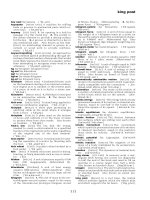Coatings Technology Handbook Episode 2 Part 4 potx
Bạn đang xem bản rút gọn của tài liệu. Xem và tải ngay bản đầy đủ của tài liệu tại đây (410.53 KB, 17 trang )
Polyesters
50
-3
convert all end groups, in order to leave residual cross-linkable functions for a coating or merely to
improve the adhesion of the coating to certain substrates.
Ta ble 50.1 lists the various ways to cross-link high or low molecular weights of various modifications.
Still the most important groups of cross-linking agents are amino resins, especially melamine–formal-
dehyde condensation resins.
12–15
Other cross-linkers are gaining in importance, however. With the rapid
growth of the market for powder coatings, polyester–epoxy hybrids and blocked isocyanate curing agents
are becoming increasingly popular.
16
Polyester–isocyanate-based binder systems are increasingly used in
solvent-borne paints, such as coil and can coatings, where a high degree of elasticity and resistance to
weather or other attacks is required. Silicone-modified polyesters are known for excellent weather resis-
tance and — with sufficiently high silicone content — good heat and chemical stability.
17
Epoxy-modified
polyesters are suitable for cross-linking with acidic resins or acid anhydrides and offer, thus, a formal-
dehyde-free and less toxic way to cross-link polyesters. Finally, acrylated polyesters serve as binders for
radiation-cured coatings for varnishes, painting inks, and adhesives.
50.3 Manufacturing Processes
50.3.1 Reaction Components
Aromatic and aliphatic polycarboxylic acids and various polyols may be used for the penetration of linear
or branched polyesters of varying molecular weight. The nature of the monomers and their relative
amounts determine the properties of the resulting copolyester. The most important raw materials for the
18–20
Whereas for the manufacture of linear polyesters,
strictly bifunctional acids and alcohols must be used, for branched polyesters a certain amount of tri-
or higher functional monomers is required. To warrant manufacture in commercial quantities on a
consistently high quality level, a high degree of purity is required for the raw materials and, where
applicable, a constant ratio of isomers. The polycondensation reaction is very sensitive to impurities, and
even small amounts of foreign matter will affect discoloration, a change in molecular weight distribution,
or even gelling.
50.3.2 Technical Manufacturing Processes
Saturated polyesters are made by esterification and transesterification. Both are reversible equilibrium
reactions that yield the desired product by continuing removal of condensation water. Under the condi-
TA BLE 50.1
Types of Polyester, Cross-linkers and Applications
Type of Polyester Cross-linker Field of Application
Linear high molecular weight
polyesters
Melamine resins, benzoguanamine Coil- and can-coating paints, primers,
coatings for collapsible tubes
Linear low molecular weight hydroxyl
polyesters
Melamine resins, benzoguanamine
resin, polyisocyanates
Industrial stoving paints, two-
component paints
Branched low molecular weight
polyesters
Melamine resins, benzoguanamine
resins, urea resins, polyisocyanates
Industrial stoving paints, two-
component powder coatings
Carboxylated polyesters Melamine resins, epoxy resins,
triglycidylisocyanurate, polyoxazolin
cross-linker
Wate rborne coatings, powder coatings
Silicone-modified polyesters Siloxane melamine resins Coil-coating paints, heat-resistant
paints
Isocyanate-modified polyesters Isocyanates, blocked polyisocyanates Coil-coating paints, industrial paints
Epoxy-modified polyesters Polyanhydrides, carboxylated
polyesters
Primers, industrial paints
Acrylated polyesters Melamine resins, radiation cure Industrial paints, adhesives, printing
inks
DK4036_book.fm Page 3 Monday, April 25, 2005 12:18 PM
© 2006 by Taylor & Francis Group, LLC
preparation of copolyesters are listed in Table 50.2.
Polyesters
50
-5
are insoluble in many common solvents. They can be dissolved only in blends of phenol and
o
-dichlo-
robenzene at higher temperatures. Polyesters of medium crystallinity are soluble in methylene chloride;
weakly crystalline polyesters will also dissolve in aromatic hydrocarbons, such as toluene. Amorphous
polyesters will dissolve in a variety of polar solvents, such as esters, etheresters, ketones, and aromatic
and chlorinated hydrocarbons.
Within the amorphous polyesters, chemical composition will have a direct effect on solubility. Thus,
shifting the glycol ratio in a polyester from ethylene glycol toward neopentyl glycol will enhance the
solubility of the resulting polyester. Detailed information on the solubility of a variety of polyesters may
be found in vendors’ literature.
24,25
Polyesters are essentially insoluble in water, unless special measures are taken to impart hydrophilic
sites. This may be achieved in one or more of the following ways: Incorporation of polyethylene oxide
segments or anionic groups, using either carboxyls (e.g., by means of trimellitic anhydride
26
) or salts of
sulfoisophthalic acid.
27
Detailed treatments on water-borne polyesters may be found elsewhere.
28,29
Tr ue
solubility of the polymers is attained only rarely. Rather, a gradual increase in water dispersibility is
observed until, by way of forming polyelectrolyte salts, a colloidal solution is obtained. Frequently,
auxiliary solvents such as butyl glycol ethers are also employed.
50.4.3 Molecular Weight Distribution
Polyesters are prepared by polycondensation, a fully reversible reaction. The desired degree of polymer-
ization is obtained by shifting the reaction equilibrium in that excess glycol is removed. A concise
treatment concerning low molecular weight linear polyesters is available in German.
4
Essentially, assuming
comparable reactivity of end groups, the molecular weight distribution is a purely statistical one. For
higher molecular weight linear polyesters, it tends to drop off fairly rapidly toward higher molecular
weights and to tail off toward lower ones. For a typical polyester, the following data were found:
M
w
=
22,200;
M
n
=
8300; and dispersity
=
2.7.
By gel permeation chromatographic analysis, a content of 3% (by area) of low molecular weight
(>1000) species was measured. One complication is the possible formation of cyclic oligomers — for
instance, the one consisting of 2 moles of terephthalic acid and 2 moles of ethylene glycol or several
others. Most of these oligomers are crystalline and tend to cause turbidity in resin solutions and,
occasionally, in paint films. Much work has been devoted to the elimination of these oligomers, resulting
in ways and means to avoid this interference factor.
30
Much more complicated is the situation when trifunctional monomers are used and branched poly-
mers are obtained.
28
As Carothers
31
and Flory
32
have shown, the molecular weight distribution broadens
rapidly with increasing degree of polymerization and soon a critical conversion point is reached, beyond
which gelation of the polymerization batch occurs. This can be avoided by a two-step process that
introduces additional functional groups in a controlled manner. A typical example for this technology
is the preparation of a branched hydroxyl polyester in a first step, followed by reaction with trimellitic
anhydride as a second step.
26,28,30
50.4.4 Functionality and Reactivity
In contrast to other polymerization processes (e.g., radical polymerization), polycondensation does not
tend to cause imperfections due to branching or chain termination. Therefore, a polyester consisting of
bifunctional components only will be just about perfectly linear. Only the incorporation of trifunctional
monomers such as trimethylol propane or trimellitic acid causes a controlled increase in functionality
above 2. As the polycondensation is generally carried out with an excess of glycol, the acid number
declines more rapidly with increasing degree of polymerization than the hydroxyl number; thus, except
for low molecular weight polyesters, the reactivity of the polyester is primarily linked to its terminal
hydroxyl groups. Because secondary hydroxyls are less reactive than primary ones, a terminal primary
hydroxyl group generally remains. This, in turn, reduces the reactivity of a polyester primarily to a
DK4036_book.fm Page 5 Monday, April 25, 2005 12:18 PM
© 2006 by Taylor & Francis Group, LLC
50
-6
Coatings Technology Handbook, Third Edition
function of its molecular weight, in accordance with the decreasing concentration of end groups with
increasing size of the polymer molecule.
50.4.5 Transition Temperatures
These transition temperatures are of interest in conjunction with polyesters. In order of importance for
coatings, there are the following:
• Glass transition temperature,
T
g
•Softening point,
T
f
•Crystalline melting point,
T
m
The theory of the relationship between thermodynamic equilibrium melting points and copolymer
compositions was developed by P. J. Flory.
33
On the basis of the free volume theory, Flory and Fox
34
proposed a general theory on glass transition theory, which led to the formula suggested by Fox,
35
which
permits the calculation of the glass transition temperature from the contributions of the individual
monomers. Polyesters obey the formula quite well. Thus, from knowledge of the glass transition tem-
peratures of the homopolyesters, copolyesters may be calculated with good accuracy. For the purpose of
this chapter, however, a few basic guidelines may be helpful.
Purely aliphatic polyesters will — with increasing ratio of methylene to ester groups — asymptotically
approach the glass transition temperature of polyethylene (N 160 K). Accordingly, a polyester of azelaic
acid and hexamethylene diol has a glass transition temperature of about 190 K, whereas one made of
terephthalic acid and bisphenol A has a glass transition temperature of 480 K. More detailed data on
glass transition temperatures of homopolyesters may be found in the literature.
36,37
For amorphous polyesters, the softening point — usually determined by the ring and ball method —
is generally approximately 50 to 90
°
C above the glass transition temperature. As one would expect, this
difference increases with increasing molecular weight.
Crystalline melting points depend largely on the chemical nature of the crystalline species. Thus, a
highly aliphatic, crystalline polyester will melt at approximately 340 K, whereas more aromatic crystalline
species will melt at considerably higher temperatures (e.g., polyethylene terephthalate, 540 K). More
information on melting points of polyesters is available.
38
50.4.6 Compatibility of Polyesters
The compatibility of polyesters with other resins and polymers depends on many parameters, which also
are partly interrelated, including molecular weight, glass transition temperature, morphology, and chem-
ical composition of the polyester. Among the most prominent examples for the use of polyesters in
combination with other polymers are blends of low molecular weight polyesters with cellulose acetoby-
tyrate in base coats of two-coat metallic automotive finishes. High molecular weight polyesters are used
as coresins for nitrocellulose lacquers and for vinyl copolymers.
24,25
50.4.7 Chemical Properties
Generally speaking, polyesters have excellent stability toward light, oxygen, water, and many chemicals.
The weakest spot in the polymer chain is the ester group, with its potential sensitivity to hydrolysis.
Accordingly, degradation may occur, provided there is an environment that combines moisture with
acids or alkali or other catalytically active materials, plus the possibility for the moisture to permeate
into the polyester. The latter is largely suppressed in the case of crystalline polyesters or for cross-linked
polyester paint films. Degradation of polyethylene terephthalate was investigated by Buxbaum.
39
Because
this author was using low molecular weight model compounds, this study may, to some extent, be
applicable to other polyesters as well.
DK4036_book.fm Page 6 Monday, April 25, 2005 12:18 PM
© 2006 by Taylor & Francis Group, LLC
Polyesters
50
-7
50.5 Analytical Procedures
In the characterization and quality control of saturated polyesters, the end groups are analyzed according
to procedures of the International Standards Organization (ISO) and the American Society for Testing
and Materials (ASTM): for hydroxyl number, ISO 4629; for acid number, ISO 3682 or ASTM D 2455.
For each type of polyester, there will be narrow limits in those two parameters. Further test methods for
polyester solutions are the nonvolatile matter content (ISO 3251, ASTM D1259), color number (Gardener
Scale, ISO 4630, ASTM D 1544), flow time (Ford cup, ISO 2431, ASTM D 1200), viscosity (ISO 3219,
ASTM D 1725), and flash point (ISO 1523, ASTM D 1310). For solid polyesters, the ring and ball method
is used to determine the softening point.
Molecular weight is frequently determined indirectly as inherent or reduced viscosity. The respective
formulas are as follows:
where
t
=
elution time of solution,
t
o
=
elution time of solvent, and
c
=
concentration.
Frequently, the control of the foregoing analytical data is not sufficient to ensure consistent quality
for the intended use. In such cases, application technical tests must be carried out to learn more about
polyester reactivity, the mechanical properties of the coating, gloss, compatibility, and adhesion, and
resistance to water, chemicals, weather, etc.
50.6 Preparation of Polyester Coatings
20
For the preparation of paints based on saturated hydroxyl polyesters, amino resins are the most commonly
chosen cross-linkers. Melakine–formaldehyde condensates are preferred over urea–formaldehyde resins
in view of the superior properties of the former in weathering stability as well as the balance of surface
hardness and elasticity. For further improvement of adhesion, gloss, and water resistance, benzoguan-
namine resins are used. Selection among the many commercially available melamine resins is primarily
determined by the compatibly of the melamine resin with the type of polyester it is to be combined with.
Monomolecular, etherified condensation products such as hexamethoxymethyl melamine or only par-
tially etherified products exhibit a very broad range of compatibility. Higher molecular weight resins
containing several melamine units in the molecule are less compatible and can be used with selected
polyesters only.
To meet the commonly established stoving conditions of 120 to 270
°
C with acceptably brief reaction
times, the cross-linking reaction between hydroxyl polyesters and amino acid resins — especially the
etherified variety — requires the use of acidic catalysts. A common choice is
p
-toluolsulfonic acid or its
salts with volatile amines, such as morpholine, or nonionically blocked acidic compounds. Hetero- or
homopolar-blocked acids are latent catalysts, which become effective only during the baking cycle.
40,41
Thus, a premature reaction between polyester and melamine resin at room temperature in the liquid
paint is effectively suppressed and the shelf life of the paint appreciably extended.
The properties of polyester coatings are essentially influenced by the molecular weight and the com-
position of the polyester as well as by the nature and the amount of the melamine resin. With increasing
amounts of amino resin, baked coatings will become harder and less elastic, whereas resistance to solvents
and chemicals increases. In general, good results are obtained with 10 to 35 wt% of total binder content.
In coil and highly elastic can coating paints, the amino resin content may be reduced to as little as 5%.
Of less commercial importance than melamine resin cross-linked polyesters are those with other cross-
linking agents such as isocyanate or epoxy cross-linked or siloxane- or radiation-cured systems. Naturally,
to avoid side reactions and insufficient shelf life when designing a paint formulation, solvents, catalysts,
pigments, additives, and fillers must be chosen with due regard for the chemistry involved.
ηη
inh red
==
−tt
c
tt
c
oo
//1
DK4036_book.fm Page 7 Monday, April 25, 2005 12:18 PM
© 2006 by Taylor & Francis Group, LLC
50
-8
Coatings Technology Handbook, Third Edition
50.6.1 Solvent-Borne Polyester Coating
20
For the preparation of solvent-borne polyester paints, all the binder components are first dissolved; then
the pigments, fillers, and additives are added, thoroughly dispersed, and milled. For reasons of economy
and to alleviate the milling procedure, it is advantageous to conduct the milling step in a fraction of the
total binder. To avoid difficulties in pigment wetting when using binders of different polarity, the fraction
used for milling should contain all the binder components in the proper proportion. Upon completion
of the milling step, the retained binder portion is added together with leveling or flow agents or other
additives and the required amounts of solvents, Paints based on saturated copolymers can be applied
with all common techniques. Those most widely practiced are roller coating for can and coil coating,
followed by various spray applications (air assisted, airless, or electrostatic spray) with, for instance,
rotating discs or belts.
50.6.2 High Solids Paints
High solids paints formulated with saturated copolyesters have total solid contents between 65 and 80
wt%. They require low viscosity — that is, low molecular weight polyesters and monomolecular melamine
— formaldehyde resins.
42–49
Due to the low molecular weight of the polyesters, the elasticity of paint
films thus obtained is inferior to that of conventional solvent-borne polyester paints. Therefore, high
solids polyesters paints are primarily used as spray-applied or dip paints. When formulating such paints,
one should take into account the high polarity of the binder and use wetting agents for better pigment
wetting, as well as effective flow agents and preferably nonionically blocked catalysts for improved
electrostatic spray applicability.
Polyester–urethane two-component paints allow the manufacture of products with higher solid content
and lower emission as compared to polyester–melamine combinations.
50.6.3 Waterborne Paints
Waterborne polyester–melamine paints are made from saturated polyesters containing an increased
amount of carboxyl groups,
5,28,50–52
having acid numbers between 45 and 55 mg KOH/g and molecular
weights of approximately 2000 g/mol. The polyesters are usually combined with water-soluble
melamine–formaldehyde resins such as hexamethoxymethyl melamine in a ratio of 70:30 to 85:15. The
use of a catalyst is not necessary, as the carboxyl groups accelerate the reaction to a sufficient degree.
Before blending these polyesters with the melamine resin, the carboxyls of the polyester must be neu-
tralized with amine, usually dimethylethanolamine. Auxiliary solvents such as butyl glycol ether may be
used to reduce viscosity, improve pigment wetting, enhance shelf life, and improve the thinning charac-
teristics of the paint. Depending on the nature of the binder, the application viscosity and the stoving
cycle, 5 to 15wt% solvent based on total paint formula is used.
Lately, it has been possible to develop polyesters with acid numbers of only about 20 mg KOH/g and
molecular weights of 4000 g/mol, which upon neutralization are thinnable with water. The higher
molecular weight allows a further reduction in emission when curing with melamine resins. Paints thus
formulated may be applied by roller; they display a high degree of flexibility and impact resistance in the
cured film.
50.6.4 Solvent-Free Coatings
Saturated polyesters play an important role for the formulation of thermosetting powder coatings. They
can be combined as carboxyl polyesters with epoxy resins or triglycidyl isocyanurate (TGIC),
7,16
or as
hydroxyl polyesters with blocked solid isocyanates, predominately isophorone diisocyanate (IPDI). Ther-
moplastic powders are used mainly to cover welding seams in cans. The preparation of powder coatings
involves blending of the binder resins with pigments, additives, and catalysts, homogenizing in a
kneader–extruder, then grinding and screening. Electrostatic spray is the prevailing application method.
DK4036_book.fm Page 8 Monday, April 25, 2005 12:18 PM
© 2006 by Taylor & Francis Group, LLC
Polyesters
50
-9
For adhesive coatings, special, low viscosity polyesters were developed.
53
The low viscosity in spite of
comparatively high molecular weight is attributed to the special structure of these polyesters, consisting
of an essentially linear main chain with a large number of alkyl side chains attached to it. By reacting
the terminal groups further, the polyesters may be functionalized to carry terminal acrylic bonds, which
render them reactive to high energy radiation such as ultraviolet light or accelerated electrons. Products
thus formulated are solvent-free. They must be applied warm by roller or slot die coating and be
radiation cured.
50.7 Properties and Applications of Polyester Coatings
Polyester coatings, especially cross-linked ones, exhibit excellent flexibility or even elasticity, and they
show very good impact, scratch, and stain resistance. Their good adhesion properties, especially to metals,
combined with good corrosion protection and weather resistance, have made them indispensable in a
number of fields.
50.7.1 Sheet and Coil Coatings
Precoated sheet and coil have enjoyed remarkable growth over the past two decades, and polyesters have
played an ever-increasing role in this industry. Polyesters are being used for primers and top coats with
equal success.
Polyester-based coil coating primers have been discussed concisely by Schmitthenner
54
and by Rob-
ertson.
55
The tough requirements that coated coil stock is expected to meet — for instance, for use as
façade sheeting — necessitate the use of primers, which have three main functions:
•Promotion of adhesion to pretreated metal
•Corrosion protection
• Elastification of the two-coat system consisting of primer and top coat
The two-coat system permits the optimization of adhesion of the primer to the pretreated metal and,
at the same time, intercoat adhesion. High molecular weight polyesters with relatively high glass transition
temperatures and in films approximately 5
µ
m thick have yielded excellent results on all counts. Corro-
sion-protective action is enhanced by the use of anticorrosive pigments. For the formulation of top coats,
the end use will influence the choice of polymers. Paints with outstanding weather resistance can be
formulated from medium molecular weight polyesters.
56
The ultraviolet (UV) absorption of polyesters
used for this purpose ends at wavelengths below those at which the UV irradiation of sunlight begins.
Schmitthenner has given another example of high molecular weight, highly elastified polyesters, that can
be used to formulate correspondingly elastic enamels for end uses such as home appliances.
50.7.2 Can Coating
The term “can coating” embraces paints for use on a vast variety of decorated metals for packaging
purposes. This includes cans of all kinds, including food cans and aerosol cans, collapsible tubes, and
caps and closures of many kinds. Generally, the paint is applied to flat sheet stock, followed by printing,
stacking up for storage, then stamping and forming. Especially difficult are the requirements for drawing
and redrawing cans and closures, where the degree of forming is too high to be achieved in a single draw.
The most common substrates are tin-plated steel, aluminum, and to a smaller extent, directly chromated
steel (tin-free steel, TFS).
Accordingly, the requirements for can coatings are extreme in many ways. They include printability
and block and scratch resistance, yet sufficient elasticity to permit forming and drawing without damage
to the paint. On the finished article, the paint must be stable with respect to its contents, it must be stain
resistant, sometimes heat sealable, and for food preservation, able to withstand sterilization, nontoxic,
and neutral in taste and odor. The composition of can coatings for use in conjunction with foodstuffs
DK4036_book.fm Page 9 Monday, April 25, 2005 12:18 PM
© 2006 by Taylor & Francis Group, LLC
50
-10
Coatings Technology Handbook, Third Edition
is regulated in many countries individually, however, the U.S. Food and Drug Administration (FDA) is
recognized internationally. The FDA provides a list of components
57
that may be used to prepare polyesters
intended for use as coatings in direct contact with food.
In conclusion, polyesters offer an excellent combination of physical properties especially concerning
the balance of elasticity and surface hardness, paired with excellent adhesion, resistance to yellowing, and
stability against the majority of materials now packaged in cans and tubes.
50.7.3 Automotive Paints
In the area of automotive paints, polyesters compete with a variety of other polymers. Acrylics, epoxy
esters, and even alkyds have their share of the market. As automotive paints are spray applied and low
molecular weight and frequently branched polyesters tend to be used predominantly, two areas have
developed as special grounds for polyesters. These are base coats for two-layered metallics and chip-
resistant fillers.
For the former, low molecular weight, branched polyesters are used in conjunction with cellulose
acetobutyrate and polymeric melamine resins. This combination permits optimum alignment of the
metallic flake pigments immediately after application. The use of polyesters for chip-resistant fillers makes
use of the excellent elasticity. Special polyester fillers made of upgraded polyurethane resin are used on
areas of the car body where stone chipping occurs most frequently (e.g., rocker panels).
50.7.4 Industrial Paints
Polyesters paints are gaining importance for the formulation of industrial baking enamels as a result of
their weathering resistance, good abrasion and chemical stability, well-balanced elasticity, and surface
hardness. This applies especially to high solids products and for waterborne sprayable and dip paints.
Te xturized paints are used for metal covers and housings for appliances, machinery, and data-processing
equipment primarily because of their good abrasion resistance and favorable hardness-elasticity proper-
ties. Automotive uses include metal parts in the engine compartment and fixtures for rearview mirrors
and windshield wipers. Polyester paints are attractive here because of their corrosion protection and
resistance to oil, fuel, and cleaning agents. Office furniture, such as steel desks and filing cabinets require
high impact resistance, which is well met by polyester paints. Similarly, household appliances — if not
made from precoated sheet — are also frequently coated with polyester-based paints.
50.7.5 Two-Component Paints
Saturated polyesters play an important role as hydroxyl-functional binder components in the formulation
of two-component polyurethane paints. Compared to other hydroxyl-functional materials, polyesters
permit complete adjustment of the elasticity of the coating of substrate, and coating is required to avoid
crack formation upon temperature fluctuations. In addition, polyesters are used in isocyanate-cured,
two-component automotive repair paints because of their weathering and chip resistance.
50.7.6 Powder Coating
Polyesters are finding use in thermosetting and thermoplastic powders. The latter are a specialty appli-
cation only. The overwhelming majority are thermosetting powders. They may be either hydroxyl poly-
esters cured with blocked isocyanates or carboxyl polyesters cured with di- or triepoxides.
The most important advantage of
thermoplastic powders
is the speed of film formation, which is
accomplished merely by melting and does not require reaction time for a chemical cure. For this purpose,
high molecular weight, partially crystalline, polyesters are best suited.
21
The use is predominantly for
coating the welding seams of three-piece cans.
22
Polyesters for use in thermosetting powders are generally amorphous, with molecular weights between
2000 and 6000, glass transition temperatures above 55°C, and softening points between 100 and 120°C.
DK4036_book.fm Page 10 Monday, April 25, 2005 12:18 PM
© 2006 by Taylor & Francis Group, LLC
Polyesters 50-11
They must have good pigment compatibility. In general, they have a functionality higher than 2, which
means branching in either the main chain or terminal components of higher functionality, as achieved
by capping with trimellitic anhydride.
58,59
Hydroxyl polyesters are generally cured with blocked isocyanates, such as isophorone diisocyanate
blocked with e-caprolactam
7,60
or uretdiones.
61
Carboxyl polyesters may either be cured with epoxy resins (polyethylene sulfide–epoxy hybrides) or with
TGIC. Polyester–epoxy hybrids enjoy the largest volume. They are very versatile and are, thus, finding use
in many and diverse applications. Their advantage over hydroxyl polyesters–blocked isocyanate materials
is the absence of blocking agents, which have to be driven off during the curing cycle. In turn, they require
catalysts, such as quarternary ammonium compounds,
62
to achieve satisfactory short curing times at
acceptable cure temperatures. Due to the relatively high content of epoxy resins (60 to 100 parts per 100
parts polyester) they have a tendency to chalking and, hence, are limited with respect to weather resistance.
The latter can be essentially improved by using TGIC at a level of approximately 10 parts per 100 parts
polyester.
63
Weather resistance of TGIC-cured carboxyl polyesters is excellent; however, powder coatings
formulated on this basis have a tendency to display orange peel upon longer storage of the powder.
64
50.7.7 Radiation-Curable Coatings
Saturated polyesters, of course, are not reactive to UV light or accelerated electrons such as used generally
for radiation cure. There are basically two ways to render them reactive:
•Incorporation into the polymer backbone of unsaturated acids, such as maleic or fumaric acid
•Capping with reactive, preferably acrylic or methacrylic, vinyl double bonds
The former method includes the unsaturated polyesters, such as those used as fiberglass-reinforced
polymers in vehicle construction with or without the use of monomeric styrene as a reactive diluent. In
the field of coatings, this material combination has found only very limited acceptance for a variety of
reasons. The only type of use worth mentioning is for furniture finishes.
Vinyl-terminated polyesters, or more specifically acrylated polyesters, may be prepared by direct
esterification of hydroxyl polyesters with acrylic acid or by reaction of carboxyl polyesters with glycidyl
methacrylate.
65
The most widely practiced method of attaching acrylic double bonds to polyesters is via the reaction
of hydroxyl polyesters, diisocyanates, and hydroxyalkyl acrylates leading to acrylated polyester urethanes.
Such materials are finding growing acceptance either by themselves or in combination with reactive
diluents for a variety of uses. The reactive diluents are predominantly di- and triacylates. The uses are
diversified; overprint varnishes in the graphics and packaging sectors are presumably the largest group.
50.7.8 Adhesives
Adhesives should be mentioned for the sake of completeness, especially the kinds that are predominantly
used in the form of continuous coatings. These include the following:
•Heat-seal lacquers and hot melt coatings
• Laminating adhesives
•Pressure-sensitive adhesives
For heat-seal lacquers and hot melt coatings, saturated, high molecular weight polyesters can be very
useful. They offer good blocking resistance and swift bonding combined with attractive physiological
properties (e.g., FDA conformity).
66
For laminating adhesives, high molecular weight polyesters may be used in conjunction with isocy-
anates to effect high bond strength, good temperature stability, and even sterilization resistance.
67
Pressure-sensitive adhesives, a totally new field for polyesters, may well gain considerable importance
in the near future.
68,69
DK4036_book.fm Page 11 Monday, April 25, 2005 12:18 PM
© 2006 by Taylor & Francis Group, LLC
50-12 Coatings Technology Handbook, Third Edition
References
1. J. Rütter, K. König, and K. H. Seemann, Ulmanns Encyclopädie, Te c hnische Chemie Vol. 19.
Weinheim: Verlag Chemie, 1980, pp. 61–88.
2. D. Stoye, Materialprüfung, 15, 410 (1973).
3. E. –C. Schütze, Oberfläche-Surface, 11, 203 (1970).
4. J. Dörffel, J. Rüter, W. Holtrup, and R. Feinauer, Farbe und Lack, 82, 796 (1976).
5. J. Dörffel and U. Biethan, Farbe und Lack, 82, 1017 (1976).
6. W. L. Hensley, Paint Varn. Prod., 68 (1966).
7. R. Gras and H. Riemer, U.S. Patent 4,528,355 (1985); Hüls.
8. R. Capanni et al., Farbe und Lack, 78, 831 (1972).
9. V. Mirgel and K. Nachtkamp, Farbe und Lack, 89, 928 (1983).
10. K. Schmitt, J. Disteldorf, and F. Schmitt, U.S. Patent 4,151,152 (1975); Hüls.
11. D. Berger, U.S. Patents 4,097,465 and 4,097,466 (1975); Hüls.
12. K. H. Homung and U. Biethan, Farbe und Lack, 76, 461 (1970).
13. U. Biethan, K. H. Homung, and G. Peitscher, Chem. Ztg., 96, 208 (1972).
14. U. Biethan and K. H. Homung, in Tenth FATIPEC Congress Book, 1970, p. 277.
15. U. Biethan, J. Dörffel, and D. Stoye, Farbe und Lack, 77, 988 (1971).
16. A. Schott, R. Gras, and E. Wolf, U.S. Patent 4,258,186 (1977); Hüls.
17. F. O. Stark, in Organic Coatings, Science and Technology, Vol. 6. New York: Dekker, 1984, pp. 87–100.
18. D. L. Edwards et al., Paint Varn. Prod., 44 (1966).
19. M. F. Koistra, J. Oil Color. Chem. Assoc., 62, 432 (1979).
20. U. Biethan et al., Ullmanns Encyclopädie Technische Chemie, Vol. 15. Weinheim: Verlag Chemie,
1978, pp. 625–628.
21. K. Brüning and K. G. Sturn, U.S. Patent 4,054,681 (1977); Dynamit Nobel.
22. H. J. Hölscher, neue Verpack., 1, 46 (1984).
23. Dynapol Copolyesters for Coatings and Adhesives (product information leaflet), Hüls AG, Marl, West
Germany.
24. Dynapol Coatings (product information ringbook), Hüls AG, Marl, West Germany.
25. Vesturit — Saturated Polyester Resins for Stoving Enamels (brochure), Hüls AG, Marl, West Germany.
26. Technical Service Report GTSR 22 and GTSR 36, Amoco Chemicals Co., Naperville, IL.
27. G. Schade, U.S. Patent 4,104,262 (1978); Dyamit Nobel.
28. J. Dörffel, Farbe und Lack, 81, 10 (1975).
29. J. Dörffel and W. Auf der Heide, Farbe und Lack, 86, 109 (1980).
30. D. W. Sartorelli and R. R. Smith, EP Patent 0105016 (1983); Goodyear.
31. W. H. Carothers, Trans. Faraday Soc., 32, 39 (1936).
32. P. J. Flory, J. Am. Chem. Soc., 63, 3083 (1941).
33. P. J. Flory, Principles of Polymer Chemistry. Ithaca, NY: Cornell University Press, 1953, pp. 568–576.
34. T. G. Fox and P. J. Flory, J. Appl. Phys., 21, 581 (1950).
35. T. G. Fox, Bull. Am. Phys. Soc., 1, 123 (1956).
36. D. W. van Krevelen, Properties of Polymers. New York: Elsevier, 1972.
37. W. A. Lee and R. A. Rutherford, Polymer Handbook, Vol. III. New York: Wiley, 1975, p. 139.
38. R. Hill, Fibres from Synthetic Polymers. London: Elsevier, 1953.
39. L. Buxbaum, Angew. Chem., 80, 225 (1968).
40. W. Andrejewski and D. Stoye, British Patent. 1 481 182 (1973); Hüls.
41. W. J. Mijs, W. J. Muizebelt, and J. B. Reesink, J. Coat. Technol., 55, 45 (1983).
42. D. Stoye, W. Andrejewski, and J. Dörffel, Thirteenth FATIPEC Congressbook, 1976, p. 605.
43. D. Stoye and J. Dörffel, Adv. Org. Coat. Sci. Technol., 2, 183 (1980).
44. D. Stoye and J. Dörffel, Pigment Resin Technol., 9(7), 4; 9(8), 8 (1980).
45. L. Gott, J. Coat. Technol., 48, 52 (1976).
46. R. Buter, Farbe und Lack, 86, 307 (1980).
DK4036_book.fm Page 12 Monday, April 25, 2005 12:18 PM
© 2006 by Taylor & Francis Group, LLC
Polyesters 50-13
47. D. Stoye and J. Dörffel, in Organic Coatings, Science and Technology, Vol. 6. New York: Dekker,
1984, pp. 257–275.
48. L. W. Hill and K. Kozlowski, J. Coat. Technol., 59, 63 (1987).
49. F. N. Jones and D. D. -L. Lu, J. Coat. Technol., 59, 73 (1987).
50. K. H. Albers, A. W. McCollum, and A. E. Blood, J. Paint Technol., 47, 71 (1975).
51. M. R. Olson, J. M. Larson, and F. N. Jones, J. Coat. Technol., 55, 45 (1983).
52. K. L. Payne, F. N. Jones, and L. W. Brandenburger, J. Coat. Technol., 57, 35 (1985).
53. H. Müller et al., U.S. Patent 4,668,763 (1987); Dynamit Nobel.
54. M. Schmitthenner, paper presented at the ECCA Annual Congress, Brussels, 1983.
55. R. R. Robertson, paper presented at the 1982 Fall Technical Meeting, NCCA.
56. M. Schmitthenner, paper presented at the Fourteenth International Conference on Organic Coat-
ings Science and Technology, Athens, 1988.
57. Federal Register, Vol. 21, Section 175.300 [Food and Drug Administration].
58. S. Harris, Polym. Paint Color J., 174 (4114), 162–164 (1984).
59. E. Bodnar and P. Taylor, Pigment Resin Technol., 15(2), 10–15 (1986).
60. R. Gras, F. Schmitt, and W. Wolf, U.S. Patent 4,246,380 (1981); Hüls.
61. R. Gras et al., U.S. Patent 4,413,079 and 4,483,798 (1984); Hüls.
62. P. L. Heater Jr., EP Patent 0 056 356 (1985); Goodyear.
63. Ciba-Geigy Bulletin, Araldit PT 810. Ciba-Geigy, Basel, Switzerland.
64. W. Marquardt and H. Germeller, Farbe und Lack, 86, 696–698 (1980).
65. J. W. Saracsan, EP Patent 0,089,913 (1983); Goodyear.
66. Dynapol Coatings Bulletin L-650 (product information), Hüls AG, Marl, West Germany.
67. Polyester Resins, Adhesives and Coatings (brochure), Dayton Chemical Division of Whittaker Corp.,
West Alexandria, OH.
68. H. F. Huber and H. Müller, Conf. Proc. Radcure, 86, 12–23 (1986).
69. H. F. Huber and H. Müller, Conf. Proc. Radcure, 87, 8–35 (1987).
DK4036_book.fm Page 13 Monday, April 25, 2005 12:18 PM
© 2006 by Taylor & Francis Group, LLC
51
-1
51
Alkyd Resins
51.1 Classification
51-
1
51.2 Principle of Alkyd Synthesis
51-
2
51.3 Functionality and Prediction for Gel Point
51-
4
51.4 Raw Materials
51-
6
51.5 Manufacturing Process
51-
7
51.6 Alkyds for Reduced Solvent Emission
51-
9
51.7 Modified Alkyds
51-
10
51.8 Uses
51-
11
References
51-
11
Alkyd resins represent a class of polymers that are used in surface coating formulations because of their
low cost and versatility. The term “alkyd” was coined by Kienle and Ferguson
1
and is derived from “al”
of alcohol and “cid” of acid; “cid” was later changed to “kyd.”
Alkyd resins in a broad sense refer to polymers. By convention, however, polyesters with unsaturation
in the backbone are not referred to as alkyds but are termed “unsaturated polyesters.”
The specific definition of alkyds that has gained wide acceptance is that alkyds are polyesters modified
with fatty acids. The nonmodified resins are then called saturated polyesters. Terms like “oil-free alkyd”
and “oil-modified polyester” can also be found in the literature.
51.1 Classification
Alkyds are synthesized from three basic components: polybasic acids, polyols, and (except for oil-free
alkyds) fatty acids. The nature and proportions of these components control the properties of the resin.
The amount of combinations is enormous, and specification of an alkyd resin must involve several
parameters. The most important ways of classifying are given below.
51.1.1 Oil Length and Type of Oil
Depending on the weight percentage of fatty acid in the resin, alkyds are referred to as short oil (<45%),
medium oil (45 to 55%), or long oil (>55%). However, some confusion exists regarding the terminology.
Krister Holmberg
Chalmers University of Technology
DK4036_book.fm Page 1 Monday, April 25, 2005 12:18 PM
© 2006 by Taylor & Francis Group, LLC
Oil Length and Type of Oil • Percentage of Phthalic Anhydride •
Actual Functionality • Gel Point • Alkyd Calculations
Acid Value and Hydroxyl Number
Polybasic Acids • Polyols • Fatty Acids and Oils
Fusion Method versus Solvent Method • Monoglyceride versus
High Solids Coatings • Emulsion-Based Coatings • Powder
Fatty Acid Process
Coatings
Polyamide Modification • Vinyl Modification • Other
Modifications
Alkyd Resins
51
-3
reactivity of the functional groups in the growing polyester chain is independent of the degree of
polymerization. In other words, at all stages of polymerization, the reactivity of every functional group
is the same. This principle of equal reactivity of functional groups, first demonstrated by Flory,
4,5
is
important for alkyd synthesis because it permits the application of statistical considerations to the
problem of distribution of the bonds formed during polymerization.
Polyesterification carried out in the absence of an added catalyst has been found to follow third-order
kinetics.
5,6
The carboxyl groups act as catalyst, and the mechanism involved is the following:
The second step is believed to be rate determining.
7
In reaction media of low dielectric constant, such
as esters and polyesters, the ions are probably associated as ion pairs. The decrease in concentration of
carboxyl groups can be expressed as follows:
If the polyesterification is performed in the presence of an acid catalyst, the reaction becomes second
order.
6,7
At high degrees of conversion, however, the reactions become sluggish. This has been ascribed
to depletion of the catalyst; at low concentration of remaining carboxyl groups, a catalyst, such as
p
-
toluenesulfonic acid, may compete favorably in reacting with hydroxyl groups, thus acting as a chain-
terminating additive.
8,9
TA BLE 51.1
Effect of Oil Length and Type of Oil on the Properties and Uses of Alkyds
Oil Type
Oil Length
(%) Typical Oil Properties
Oxidizing
≥
60 Linseed, safflower, soybean, tall oil
fatty acids; wood oil in blends with
other oils; dehydrated castor oil
Soluble in aliphatic solvents; compatible with oils
and medium oil length alkyds; good drying
characteristics; films are flexible, with reasonable
gloss and durability
Oxidizing 45–55 Linseed, safflower, soybean, tall oil
fatty acids; wood oil in blends with
other oils
Soluble in aliphatic or aliphatic–aromatic solvent
mixtures; good drying characteristics, durability,
and gloss
Oxidizing
≤
45 Linseed, safflower, soybean, tall fatty
acids; wood oil in blends with other
oils; dehydrated castor oil
Soluble in aromatic hydrocarbons; low tolerance
for aliphatic solvents; usually cured at elevated
temperatures either by heating with manganese
driers or with urea or melamine formaldehyde
resins
Nonoxidizing 40–60 Coconut oil, castor oil, hydrogenated
castor oil
Soluble in aliphatic–aromatic solvent blends;
usually used as a plasticizer for thermoplastic
polymers such as nitrocellulose
Nonoxidizing
≤
40 Coconut oil, castor oil, hydrogenated
castor oil
Soluble in aromatic solvents; used as a reactive
plasticizer that chemically combines with other
resin entities (e.g. melamine–formaldehyde
resin)
Source
: From Solomon, D. H.,
The Chemistry of Organic Film Formers.
New York: Krieger, 1977, p. 91.
2
2
2
11
RCOOH RCOO RCOOH
RCOOH R OH RCOOHR
→+
←
+→ +
−+
++
HHO
RCOOHR RCOO RCOOR RCOOH
2
11
←
+→ +
←
+−
−= ⋅
d
dt
k
[]
[][]
COOH
COOH OH
2
DK4036_book.fm Page 3 Monday, April 25, 2005 12:18 PM
© 2006 by Taylor & Francis Group, LLC
51
-8
Coatings Technology Handbook, Third Edition
TA BLE 51.3
Typical Fatty Acid Composition (%) of Vegetable Oils
Fatty Acid
Ve getable Oils
Castor Coconut Linseed Olive Palm Palm Kernel Peanut Safflower Soybean Sunflower Tall Tung
C8 Caprylic 6 3
C10 Capric 6 4
C12 Lauric 44 51
C14 Myristic 18 1 17
C16 Palmitic 2 11 6 16 48 8 6 8 11 11 5 4
C18 Stearic 1 6 4 2 4 2 5 3 4 6 3 1
C18 Oleic 7 7 22 64 38 13
61 13 25 29 46 8
C18 Linoleic 87 2 16 16 9 2 22 75 51 52 41 4
C18 Linolenic 3 52 2 1 9 2 3 3
C18 Eleostearic
80
C18 Ricinoleic
C20 Arachidic
2 2
Source:
From Holmberg, K.,
High Solids Alkyd Resins.
New York: Dekker, 1987.
DK4036_book.fm Page 8 Monday, April 25, 2005 12:18 PM
© 2006 by Taylor & Francis Group, LLC
51-12 Coatings Technology Handbook, Third Edition
28. S. Paul, Surface Coatings: Science and Technology, 2nd ed. New York: Wiley, 1996.
29. A. G. North, J. Oil Colour Chem. Assoc., 39, 695 (1956).
30. E. F. Redknap, J. Oil Colour Chem., Assoc., 43, 260 (1960).
DK4036_book.fm Page 12 Monday, April 25, 2005 12:18 PM
© 2006 by Taylor & Francis Group, LLC
52
-1
52
The Polyurea
Revolution: Protective
Coatings for the
21st Century
52.1 History
52-
1
52.2 Polyureas versus Polyurethanes/Chemistry
52-
1
52.3 Application Characteristics
52-
2
52.4 General Performance
52-
2
52.5 Weathering Characteristics
52-
2
52.6 Chemical, Water, and Corrosion Resistance
52-
2
52.7 Safety
52-
3
52.8 Conclusion
52-
4
Welcome to the new world of polyureas. In the time it is taking you to read this sentence, a polyurea
elastomeric coating, mixed and sprayed onto a surface, will have reached its initial set.
52.1 History
Polyureas were first developed in the 1970s, but the development of any practical application was impeded
by their extremely short set times of 1 to 3 sec. In the early 1980s, sophisticated, plural-component heated
equipment was able to mix quickly and dispense the polyureas into a usable form. Throughout the 1980s
and 1990s, improvements in polyurea chemistry led to products with set times that ranged from 3 sec
to 25 min. This led to a wide variety of practical applications.
52.2 Polyureas versus Polyurethanes/Chemistry
Polyureas, as the name suggests, are closely related to polyurethanes. Both polyureas and polyurethanes
are based on a two-component system, with one component being an isocyanate material. Polyureas’
second component is a polyether polyamine, whereas polyurethanes’ second component is a polyether
polyol. Polyurethanes require a catalyst to speed up the reaction time of the components, whereas
polyureas do not. The polyurethane reaction is sensitive to low temperatures and moisture due to the
addition of catalysts. Low temperatures inhibit the reaction time. Moisture interferes with the reaction
by creating carbon dioxide, which causes blistering in the polyurethanes. Polyureas, on the other hand,
require no catalyst, so they are able to cure at any temperature and in the presence of moisture. The fast
curing ability of polyureas is inherent in their chemistry, which gives them several unique advantages.
Bruce R. Baxter
Specialty Products, Inc.
DK4036_book.fm Page 1 Monday, April 25, 2005 12:18 PM
© 2006 by Taylor & Francis Group, LLC
53
-1
53
Phenolic Resins
53.1 Rigid Packaging
53-
2
53.2 Maintenance Primers
53-
3
53.3 Printing Inks
53-
3
53.4 Epoxy Hardeners
53-
4
53.5 Summary
53-
4
References
53-
5
Synthetic phenolic resins were developed and commercialized in the early 1900s by Leo Baekland.
1
The
reaction of phenol and formaldehyde produces a product that forms a highly cross-linked three-dimen-
sional polymer when cured. The resins have found use in various applications in the coatings industry
because of their excellent heat resistance, chemical resistance, and electrical properties. They also offer
good adhesion to many substrates and have good compatibility with other polymers.
Phenolic resins have two basic classifications: resoles and novolaks. Resoles, or heat-reactive resins,
are made using an excess of formaldehyde and a base catalyst. The polymer that is produced has reactive
methylol groups that form a thermoset structure when heat is applied.
Novolaks are made using an excess of phenol and an acid catalyst. Reaction occurs by the protonation
of the formaldehyde,
2
and the intermediate is characterized by methylene linkages rather than methylol
groups. These products are not heat reactive, and they require additional cross-linking agents such as
hexamethylenetetramine to become thermosetting. These reactions can be thought of as nucleophilic
attack of phenoxide ion on the formaldehyde, or electrophilic substitution by protonated formaldehyde
on the aromatic ring.
3
Both polymerization reactions evolve water during cure. This condensation reaction serves to limit
film thickness to approximately 3 mils, because the volatiles will cause blistering while curing takes place.
Baking temperatures are generally 300 to 400
°
F with a bake time of 10 to 30 min.
Phenolic resin polymers have been used in the coatings industry for many years because of their
excellent performance properties and their relatively low cost. Some of the major applications are in rigid
packaging, maintenance primers, printing inks, and epoxy hardeners. A brief discussion of these appli-
cations follows.
Base
Formaldehyde
H
2
C
CH
2
OH
OH
OH OH
CH
2
CH
2
OH
OH
Kenneth Bourlier
Union Carbide Corporation
DK4036_book.fm Page 1 Monday, April 25, 2005 12:18 PM
© 2006 by Taylor & Francis Group, LLC









